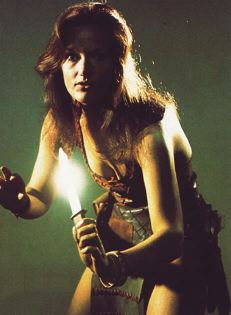

Elisabeth Sladen's departure gave Philip Hinchcliffe and Robert Holmes the opportunity to put their own stamp on the programme with a Companion character of their design. Their initial thought was for a character similar to Eliza Doolittle in George Bernard Shaw's play Pygmalion (and later the musical My Fair Lady). This would be a character initially naive and unsophisticated who would learn from the Doctor.
Meanwhile, Chris Boucher was working on a story called "The Mentor Conspiracy" with a character named Leela after a Palestinian terrorist. She was to be "brave, bright, primitive, proud, and curious, and who, despite her basic naivete, didn't have the habit of deference." Hinchcliffe and Holmes were impressed by the character (though not by the story) and thought they might be able to incorporate into her some of the Eliza Doolittle elements.
Boucher submitted a new script initially called "The Day God Went Mad" (changed to "The Face of Evil") and reused the character of Leela. Reflecting the potential interest in her as a Companion, he provided two endings: one where Leela stays behind and one where she accompanies the Doctor into the TARDIS and leaves with him.
Leela is human but from the far future, on a planet where an Earth expedition has become marooned. Centuries have passed, enough time for the survivors to have forgotten their origins and to have become separated into two tribes, one descended from the technicians who stayed with the ship (the Tesh) and one descended from the survey team who left the ship to explore the planet (the Sevateem). The Sevateem are a tribe of violent savages with little respect for life, and Leela is one of them in these respects.
As a result, she becomes the first Companion to truly break the image of the traditional runner and screamer. Every prior Companion who had originally been intended to break the mold ended up falling into it, but not Leela. Louise Jameson saw to that:
I was literally getting scripts that had been written for Sarah Jane Smith. They changed the odd line for Leela, but there were still things like "Leela screams and runs and hides," and I said, "No, Leela doesn't." I had to fight long and hard on that one.Leela was to scream only once, during "Talons of Weng-Chiang" when the giant rat was gnawing her leg. That has to be some kind of record, at least until Ace came along.
Leela stands out in another respect, too, and that is her skimpy costume, which the guys at least find extremely memorable. It was definitely deliberate on the part of Hinchcliffe, with his goal keeping the male viewers tuned in following the football results that immediately preceded Doctor Who at the time. It appeared to be a success.
Not that much was ever made of the Eliza Doolittle aspect of the character, with perhaps a few nods in that direction during "Talons." As always (again, at least until Ace came along), the Companion tends to be an afterthought. And Leela, after having one of the best entrances into the TARDIS ever ("Don't touch that!") goes out in one of the weakest exits of any Companion, betrothed to a wimpy Chancellery Guard on Gallifrey. It is an unfitting end to one of the most distinctive characters in Doctor Who's long history.